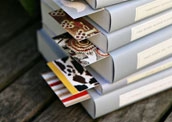- All our books
- Categories:
- Adultery
- America
- Architecture
- Biography
- Bloomsbury
- Childhood
- Children (books for)
- Cookery Books
- Country Life
- Diaries
- Education
- Family
- Fathers
- Gay and Lesbian
- Grandmothers
- History
- House and Garden
- Humour
- Ireland
- London
- Love Story
- Men (books about)
- Men (books by)
- Mothers
- North of England
- Overseas
- Poetry
- Politics
- Race
- Science Fiction
- Scotland
- Sex
- Shopping
- Short Stories
- Single Women
- Social Comedy
- Suffragettes
- Teenagers (books for)
- Thrillers
- Translations
- Victoriana
- Widows
- Woman and Home
- Working Women
- WWI
- WWII
- Persephone Merch.
- Audiobooks
- Book Tokens
- Notebook
- Persephone Classics
- Catalogue
Find a book

A Book a Month
We can send a book a month for six or twelve months - the perfect gift. More »

Café Music
Listen to our album of Café Music while browsing the site. More »
Order This Book

PREFACE BY JANET MORGAN
432pp
ISBN 9781903155745
A recipe book first published in 1806 of the sort Jane Austen might have used if she'd ever cooked a meal in her life (which of course she didn't).
We first came across Mrs Rundell's New System of Domestic Cookery in The Jane Austen Cookbook by Maggie Black and Deirdre Le Faye. The Cookbook has ten of Mrs Rundell’s recipes: for beef-steak pudding, apple pie, solid syllabubs, apple puffs, salmagundy, oyster loaves, little iced cakes, pigeon pie, orange peel straws in syrup, and rout drop cakes.
We then read about Mrs Rundell in the Guardian – when the John Murray Archive went to the National Library of Scotland there was an article about her because her bestselling cookery book was the foundation for the success of John Murray as a publisher. The new Persephone Preface is by Janet Morgan, a writer and member of the Library Board of Trustees; she explains Mrs Rundell’s interesting but sometimes troubled relationship with the firm of John Murray. Domestic Cookery was, Mrs Rundell said, ‘intended for the conduct of the families of the authoress’s own daughters, and for the arrangement of their table, so as to unite a good figure with proper economy... This little work would have been a treasure to herself when she first set out in life, and she therefore hopes it may prove useful to others.’ As well as its extensive and varied list of ‘receipts’, more than a thousand, it addressed multiple daily domestic challenges. ‘To make Paste for Chapped Hands, and which will preserve them smooth by constant use...’; ‘To cement broken China’; ‘To take Stains of any kind out of Linen...’; ‘...To make Flannels keep their colour and not shrink...’; ‘...To dye White gloves a Beautiful Purple...’
And, Janet Morgan continues: ‘Daily life in the nineteenth century had a long agenda: “To make Pot Pourri; an excellent Water to prevent hair from falling off, and to thicken it [a mixture of unadulterated honey, tendrils of vines and rosemary-tops]; Black Ink; Fine Blacking for Shoes.” Evidently Mrs Rundell did not keep to her morning room, marking up menus submitted by Cook, but was pleasurably engaged in growing, harvesting, and buying food. She reared her own hens in yards and poultry-houses built to her specification. Roosting arrangements and systems for deterring foxes and other predators were described. If the hens did not lay (she had a prescription to encourage them), she knew how to choose eggs at the market: “Put the large end of the egg to your tongue; if it feels warm it is new.” Butter, too, is best from home but, if none can be made there, she knew how to test the offerings at the butter-stall: “Put a knife into the butter if salt, and smell it when drawn out....” Tasting butter sold from barrels needs special persistence: “Being made at different times, the layers in casks will vary greatly; and you will not easily come at the goodness but by unhooping the cask, and trying it between the staves.” The dairyman surely forgives this customer, who, having dismantled his barrels, finds joy in the contents: “Fresh butter ought to smell like a nosegay.”’
A New System of Domestic Cookery by Mrs Rundell was reprinted many, many times throughout the nineteenth century. It was also a bestseller in the United States: from 1806-44 there were fifteen American editions. Yet this is the first time Domestic Cookery has been published for over a hundred years. We have used the 1816 edition, which appeared the same year as Jane Austen's novel Emma, and are confident that, over two hundred years on, Persephone readers will find it both useful and entertaining, as well as being a work of social history in itself.
Endpaper
A block-printed cotton in Lapis style, 1808-15, © V & A Museum
Read What Readers Say
Bee Wilson, ‘The Telegraph’
Categories: Cookery Books
